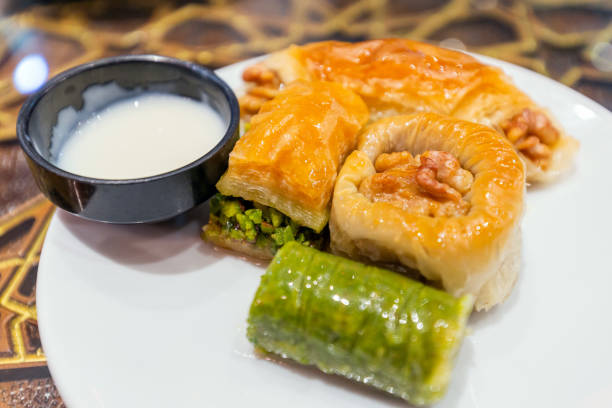Turkish baklava is much more than a dessert—it is an enduring symbol of cultural heritage, artistry, and culinary excellence. Known for its delicate layers of phyllo dough, nutty fillings, and syrupy sweetness, baklava has captivated food enthusiasts worldwide for centuries. In this blog, we’ll explore the history, preparation, cultural significance, and modern innovations of this iconic dessert.
What Makes Turkish Baklava So Special?
Baklava’s allure lies in its impeccable craftsmanship and the harmony of flavors. The dessert begins with the preparation of phyllo dough, which is rolled to paper-thin layers by skilled artisans. These layers are carefully stacked and filled with crushed pistachios, walnuts, or hazelnuts, depending on the region. Each layer is brushed with melted clarified butter, ensuring the perfect crisp texture. After baking, the baklava is soaked in a fragrant syrup made from sugar, water, and lemon juice, with optional hints of rose or orange blossom water. The result? A dessert that is crispy yet tender, rich yet balanced.
The History of Turkish Baklava
The origins of baklava are often debated, but its most prominent roots trace back to the kitchens of the Ottoman Empire. Records suggest that baklava was served to royalty and dignitaries as early as the 15th century. The dessert was prepared in the Topkapı Palace, where expert chefs refined its recipe to perfection.
One of the most famous regional variations comes from Gaziantep, a city in southeastern Turkey known for its pistachios. Gaziantep baklava is so highly regarded that it holds a Protected Geographical Indication (PGI), a testament to its authenticity and cultural significance. Over the years, baklava became a staple of Turkish households, especially during celebrations like Eid, weddings, and other festive occasions.
Cultural Significance of Baklava
Baklava is more than just a sweet treat; it is deeply ingrained in Turkish culture and traditions. During Ramadan, families prepare and share baklava to mark the end of fasting and to celebrate the holy month. Similarly, it is a popular dessert served at weddings, where it symbolizes prosperity and joy.
Offering baklava to guests is also a gesture of hospitality in Turkey. It’s a way of expressing generosity and care, ensuring that guests feel welcomed and valued. In Turkish homes, baklava often becomes the centerpiece of family gatherings, creating moments of connection and shared joy.
The Craft of Making Baklava
Making baklava is no ordinary task it is a labor-intensive process that demands skill, patience, and precision. The phyllo dough, for instance, must be rolled so thin that it becomes almost translucent. Achieving this requires years of practice and expertise.
The layering process is equally meticulous. Each sheet of phyllo is brushed with melted butter, ensuring even cooking and a golden-brown finish. The nut filling must be evenly distributed, and the dessert is often cut into diamond or square shapes before baking. Once baked, the syrup is poured while the baklava is still hot, allowing it to soak in and infuse every layer with sweetness.
Modern Takes on Traditional Baklava
While traditional baklava remains a beloved classic, modern twists have given the dessert a new dimension. Chocolate baklava, for instance, combines the rich flavors of cocoa with the traditional phyllo and nut base. Vegan-friendly baklava, made with plant-based ingredients, caters to those with dietary preferences without compromising on taste.
Savory baklava variations have also emerged, featuring fillings like cheese or spinach for a unique twist on the classic dessert. These innovations honor the original while introducing baklava to new audiences and culinary contexts.
Why Turkish Baklava Stands Out Globally
Turkish baklava is celebrated worldwide for its unmatched quality and flavor. Unlike other versions, Turkish baklava often uses minimal ingredients but emphasizes their quality. Pistachios from Gaziantep, for instance, are renowned for their vibrant color and rich flavor, adding a distinct character to the dessert.
The balance of sweetness is another defining feature. Unlike overly sugary variations, Turkish baklava maintains a delicate equilibrium, allowing the natural flavors of the nuts and syrup to shine through. Whether enjoyed with Turkish tea or coffee, baklava offers a harmonious pairing that elevates the experience.
How to Best Enjoy Baklava
To truly savor baklava, pair it with traditional Turkish tea or coffee. The strong, bitter notes of the beverages complement the sweetness of the dessert, creating a perfect balance. Baklava is best served at room temperature, allowing the layers to retain their texture and the syrup to fully infuse the pastry.
For those visiting Turkey, a trip to Gaziantep is a must. Here, you can experience baklava in its most authentic form, crafted by generations of skilled bakers. From the bustling streets of Istanbul to quaint villages, baklava is a shared culinary treasure that connects people and places.


